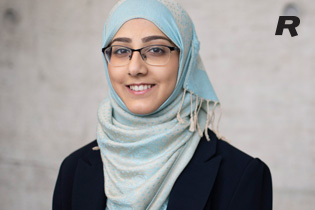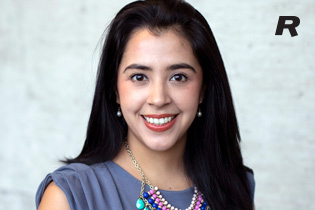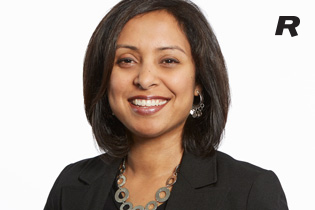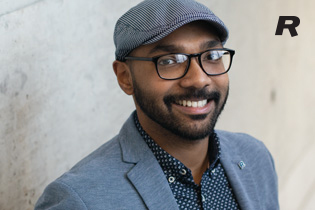 Narjis Premjee (MBA ’19) kicked off her second year of the Full-Time MBA ready to take on some of the most pressing issues plaguing business and society today.
Narjis Premjee (MBA ’19) kicked off her second year of the Full-Time MBA ready to take on some of the most pressing issues plaguing business and society today.
Every week, for the Designing for Equality class at Rotman, she came ready to discuss and debate a range of ideas: from approaches to pay equity to the concept of instituting quotas on corporate boards. Outside of class, she and her classmates were also conducting field work so that they could eventually design and prototype solutions aimed specifically at supporting women with saving and accruing wealth.
For Premjee, the class wasn’t about a mark on a transcript, but about making an impact.
“The real reward came during one of our final classes, when we presented our ideas to executives from a major Canadian bank,” says Premjee. “One of our guests said that some of findings were very relevant in her work, right now.”
“To me, that was better than any grade or accolade — it was confirmation that we had done our job and come up with practical ideas that could really make a difference.”
Giving students the tools to accomplish big things
Designing for Equality was developed by the Institute for Gender and the Economy (GATE). It is a class that draws on the unique strengths of the Rotman School — and unlike any other offered at a business school. The course focuses on one of the most complex challenges in society — achieving gender equality. From the outset, MBA students are pushed to go beyond superficial discussions or stereotypes by building on scholarly, often myth-busting research. At the same time, the course is designed to be practical and hands-on.
“True progress starts with really acknowledging and picking apart your own biases.”
— Pallavi Armoogum, Morning MBA ’19
“The ultimate goal of the course is to give students the tools to step out into the real world and accomplish something,” says instructor Vanessa Iarocci, who is also an executive-in-residence with GATE.
Having held progressively senior roles in finance over the course of nearly two decades, Iarocci not only understands the challenges professional women face in the workplace, she has substantial experience tackling prevalent gender equity issues — including leading a TD Bank-wide initiative aimed at supporting women with financial planning.
With Rotman Professor and GATE Director Sarah Kaplan, Iarocci designed a class that covered all the things she wishes her younger self had known.
“From the beginning, I knew this wasn’t going to be another lecture-based class. What we really need is a class to engage students in how to solve gender problems.”
Each week, she pushes her students to adopt a Business Design mindset to rethink the problem they are trying to solve and to involve the people experiencing the problem in coming up with a solution.
“For years, we’ve used design frameworks to solve complex business issues. Now it’s time to use these approaches to take on even more complex problems like gender equality,” she says. “After all, people are finally waking up to the fact that social innovation is essential to good business.”
Hands-on learning that will serve students in the years to come
 Students learn about these design frameworks first hand by tackling a real-world gender equity issue for their major project. Last semester, the class was tasked with developing strategies for improving saving and investing behaviours among women.
Students learn about these design frameworks first hand by tackling a real-world gender equity issue for their major project. Last semester, the class was tasked with developing strategies for improving saving and investing behaviours among women.
“It’s a real and nuanced issue that all Canadian banks are dealing with right now,” Iarocci explains. “It’s not that women aren’t capable or interested in saving or investing, rather that many financial services haven’t been designed to engage them in real conversations. I wanted the class to really investigate the issues and think about innovative solutions.”
That’s exactly what students took away from the experience.
Iarocci took the class through the whole process, describes Verónica Hernandez Herrera (MBA ’19). “By using the design framework, step-by-step, we saw our problem statement evolve and become more focused as we learned more about the subject and collected feedback from the class.”
For her project, which she worked on with Premjee and another student, they chose to zero in on new moms. Following the design framework, they interviewed women in their target demographic, scanned financial services offered by leading firms and eventually came up with a suite of workshops that they felt would benefit new parents the most.
“I really felt that after every Designing for Equality class, I left with a lesson that would serve me in my future career.”
Unpacking the problem and confronting personal biases
 Many of the themes covered in the class also hit home for students like Pallavi Armoogum (Morning MBA ’19), a working professional specializing in corporate and investment communications, who has always been passionate about gender equity.
Many of the themes covered in the class also hit home for students like Pallavi Armoogum (Morning MBA ’19), a working professional specializing in corporate and investment communications, who has always been passionate about gender equity.
“I’ve always hoped for a future where I’d be able to show up as I am — as a female and as a member of a minority group — and having my skills and voice valued just as much as everyone else’s,” explains Armoogum.
“I knew that achieving gender equality would be a huge, messy, overwhelming challenge,” she adds. “But the course helped me see that it’s a problem that could be solved by breaking it down into smaller pieces and developing a collection of solutions.”
For her, the most important learnings came out of the classroom discussions and weekly debates — especially when she was asked to debate for an opposing perspective.
“In some classes, for certain issues, I realized that maybe I didn’t stand so firmly on one side,” she explains. “True progress starts with really acknowledging and picking apart your own biases.”
 Many graduates of the class, like Mohsin Bin Latheef (MBA ’18), have realized that tackling personal biases and applying design principles are part of the job. Today, as a senior consultant with PwC, he often looks back on what he’s learned.
Many graduates of the class, like Mohsin Bin Latheef (MBA ’18), have realized that tackling personal biases and applying design principles are part of the job. Today, as a senior consultant with PwC, he often looks back on what he’s learned.
“The class was completely different than any other at Rotman,” says Bin Latheef, who took the class when it first launched in the fall semester of 2017. “Most importantly, it taught me to start from a blank slate and to put myself in the shoes of other people when solving a problem.”
Bin Latheef’s interest in business design and how it could be applied to solving social problems was what initially motivated him to apply for the course. Through the readings, discussions and project work, he ended up with a new outlook in both work and life.
“I walked away with a much richer perspective of the gender-related challenges that exist in business and a clearer idea of how to apply a design lens to tackling them,” he says. “It’s informed how I engage with my colleagues, friends — and even with my wife.”
Written by Rebecca Cheung | More Student Stories »